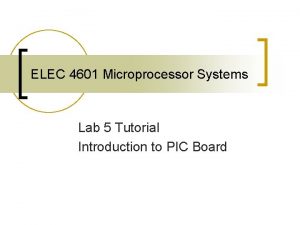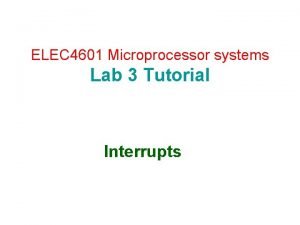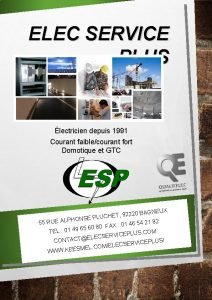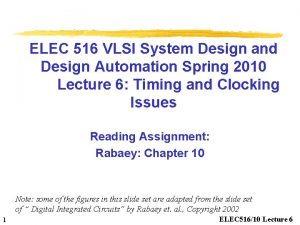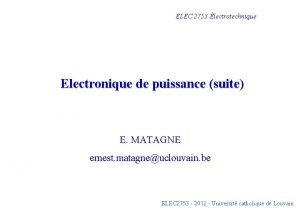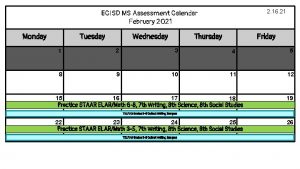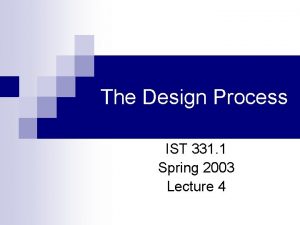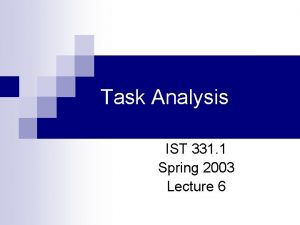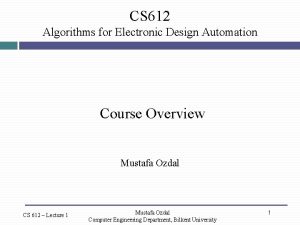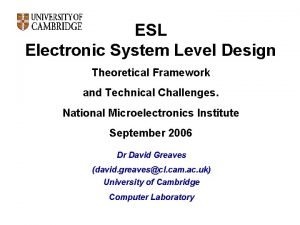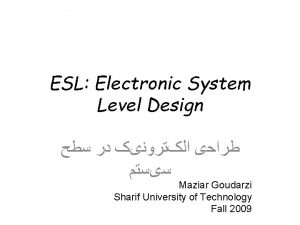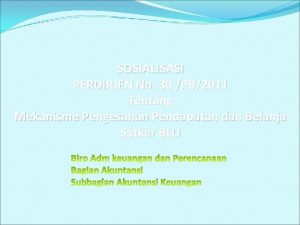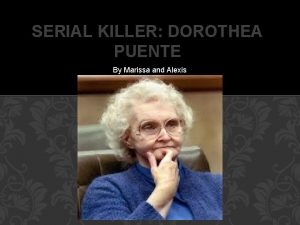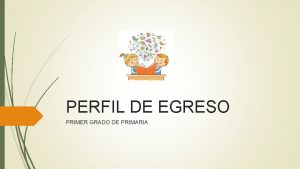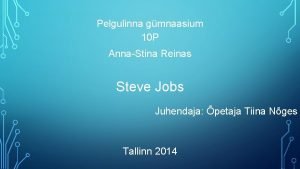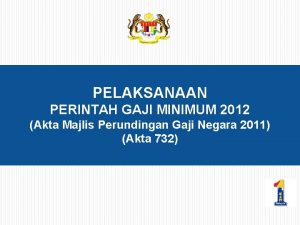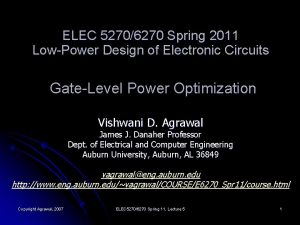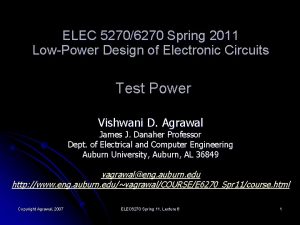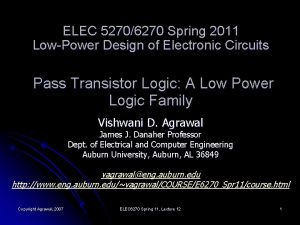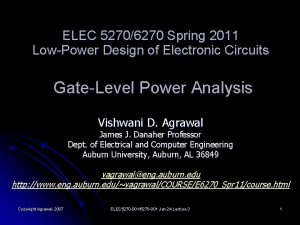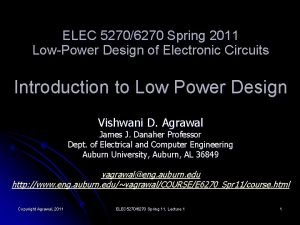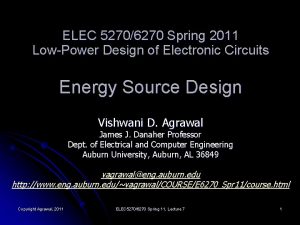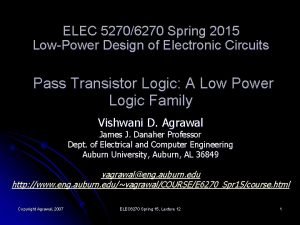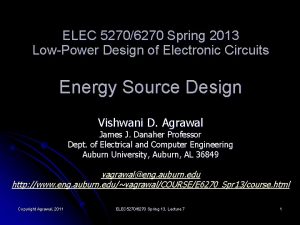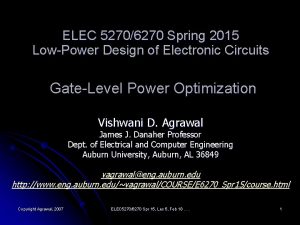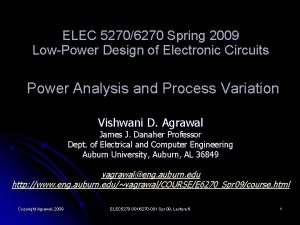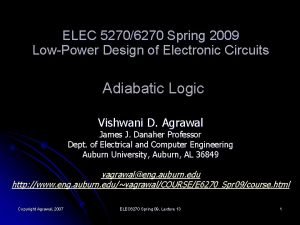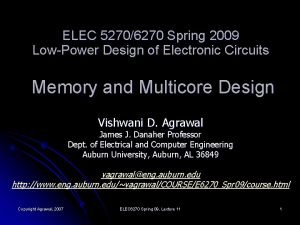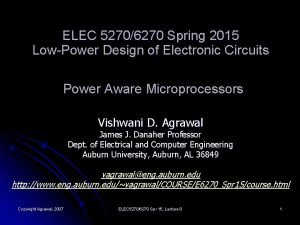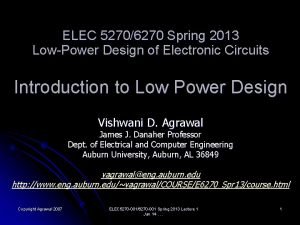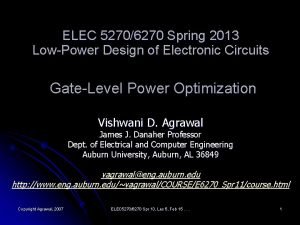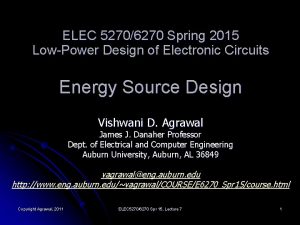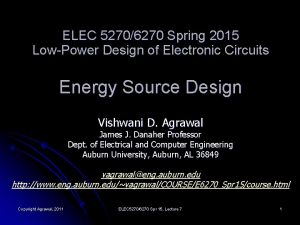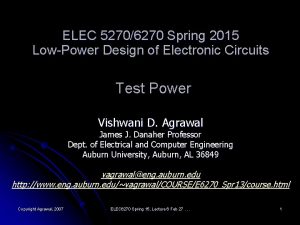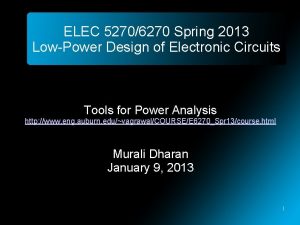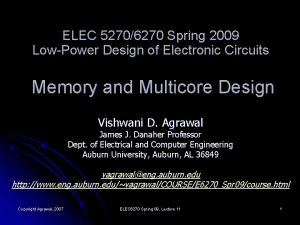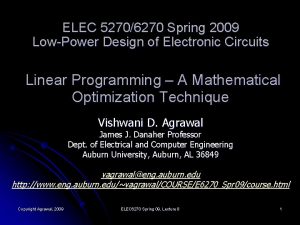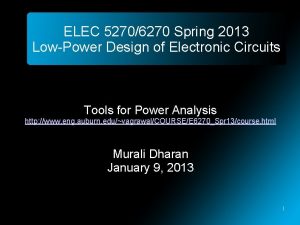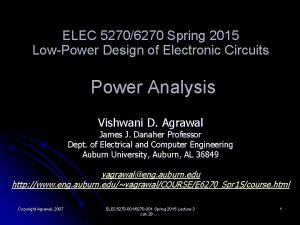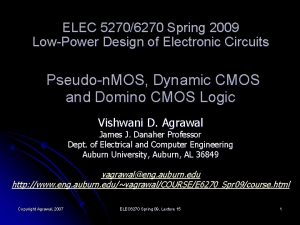ELEC 52706270 Spring 2011 LowPower Design of Electronic








![i(t) = C dv(t)/dt = [V – v(t)] /R dv(t) V – v(t) ─── i(t) = C dv(t)/dt = [V – v(t)] /R dv(t) V – v(t) ───](https://slidetodoc.com/presentation_image_h2/d635988f2c1d5c3a4ef611c767e8fb5b/image-9.jpg)
![v(t) = i(t) Copyright Agrawal, 2007 = –t V [1 – exp( ── )] v(t) = i(t) Copyright Agrawal, 2007 = –t V [1 – exp( ── )]](https://slidetodoc.com/presentation_image_h2/d635988f2c1d5c3a4ef611c767e8fb5b/image-10.jpg)




![i(t) = C dv(t)/dt = dv(t) ─── dt = [V(t) – v(t)] /R V(t) i(t) = C dv(t)/dt = dv(t) ─── dt = [V(t) – v(t)] /R V(t)](https://slidetodoc.com/presentation_image_h2/d635988f2c1d5c3a4ef611c767e8fb5b/image-15.jpg)

![Constant Current Is Optimum I(t) R t = [0, T] V C Copyright Agrawal, Constant Current Is Optimum I(t) R t = [0, T] V C Copyright Agrawal,](https://slidetodoc.com/presentation_image_h2/d635988f2c1d5c3a4ef611c767e8fb5b/image-17.jpg)

















- Slides: 34

ELEC 5270/6270 Spring 2011 Low-Power Design of Electronic Circuits Adiabatic Logic Vishwani D. Agrawal James J. Danaher Professor Dept. of Electrical and Computer Engineering Auburn University, Auburn, AL 36849 vagrawal@eng. auburn. edu http: //www. eng. auburn. edu/~vagrawal/COURSE/E 6270_Spr 11/course. html Copyright Agrawal, 2007 ELEC 6270 Spring 11, Lecture 8 1

Examples of Power Saving and Energy Recovery l Power saving by power transmission at high voltage: l l 1000 W transmitted at 100 V, current I = 10 A If resistance of transmission circuit is 1Ω, then power loss = I 2 R = 100 W Transmit at 1000 V, current I = 1 A, transmission loss = 1 W Energy recovery from automobile braking: l l l Normal brake converts mechanical energy into heat Instead, the energy can be stored in a flywheel, or Converted to electricity to charge a battery Copyright Agrawal, 2007 ELEC 6270 Spring 11, Lecture 8 2

Reexamine CMOS Gate V 2 / R p V Most energy dissipated here i = Ve–t/Rp. C/Rp v(t) p Power i 2 R V×i = V 2 e– 2 t/Rp. C/ Rp C v(t) 3 Rp. C 0 Energy dissipation per transition = Area/2 = C V 2/ 2 Copyright Agrawal, 2007 V ELEC 6270 Spring 11, Lecture 8 Time, t 3

Charging with Constant Current i = constant v(t) = it/C C Power i 2 Rp C 2 V 2 R 0 Time (T) to charge capacitor to voltage V v(T) = V = i. T/C, or T = CV/i Current, i = CV/T Copyright Agrawal, 2007 p /T 2 Time, t it/C V 0 T=CV/i Output voltage, v(t) V(t) Power = i 2 Rp = C 2 V 2 Rp/T 2 Energy dissipation = Power × T = (Rp. C/T) CV 2 ELEC 6270 Spring 11, Lecture 8 4

Or, Charge in Steps 0→V/2→V i = Ve–t/Rp. C/2 Rp C V 2 e– 2 t/Rp. C/4 Rp V 2/4 Rp 0 Energy = Area = CV 2/8 V v(t) Power v(t) i 2 Rp V/2 3 Rp. C 6 Rp. C Time, t Total energy = CV 2/8 + CV 2/8 = CV 2/4 Copyright Agrawal, 2007 ELEC 6270 Spring 11, Lecture 8 5

Energy Dissipation of a Step Voltage step = V/N T E = ∫ V 2 e– 2 t/Rp. C/(N 2 Rp) dt 0 = [CV 2/(2 N 2)] (1 – e– 2 T/Rp. C) ≈ CV 2/(2 N 2) for large T ≥ 3 Rp. C Copyright Agrawal, 2007 ELEC 6270 Spring 11, Lecture 8 6

Charge in N Steps Supply voltage 0 → V/N → 2 V/N → 3 V/N →. . . NV/N Current, i(t) = Ve–t/Rp. C/NRp Power, i 2(t)Rp = V 2 e– 2 t/Rp. C/N 2 Rp Energy = N CV 2/2 N 2 = CV 2/2 N → 0 for N → ∞ Delay Copyright Agrawal, 2007 = N × 3 Rp. C → ∞ for N → ∞ ELEC 6270 Spring 11, Lecture 8 7

Reexamine Charging of a Capacitor R t=0 i(t) V v(t) C Charge on capacitor, q(t) = C v(t) Current, i(t) = C dv(t)/dt Copyright Agrawal, 2007 = dq(t)/dt ELEC 6270 Spring 11, Lecture 8 8
![it C dvtdt V vt R dvt V vt i(t) = C dv(t)/dt = [V – v(t)] /R dv(t) V – v(t) ───](https://slidetodoc.com/presentation_image_h2/d635988f2c1d5c3a4ef611c767e8fb5b/image-9.jpg)
i(t) = C dv(t)/dt = [V – v(t)] /R dv(t) V – v(t) ─── = ───── dt RC dv(t) dt ∫ ───── = ∫ ──── V – v(t) RC –t ln [V – v(t)] = ── + A RC Initial condition, t = 0, v(t) = 0 → A = ln V –t v(t) = V [1 – exp(───)] RC Copyright Agrawal, 2007 ELEC 6270 Spring 11, Lecture 8 9
![vt it Copyright Agrawal 2007 t V 1 exp v(t) = i(t) Copyright Agrawal, 2007 = –t V [1 – exp( ── )]](https://slidetodoc.com/presentation_image_h2/d635988f2c1d5c3a4ef611c767e8fb5b/image-10.jpg)
v(t) = i(t) Copyright Agrawal, 2007 = –t V [1 – exp( ── )] RC dv(t) C ─── dt = ELEC 6270 Spring 11, Lecture 8 V –t ── exp( ── ) R RC 10

Total Energy Per Charging Transition from Power Supply Etrans = = Copyright Agrawal, 2007 ∞ ∫ V i(t) dt = 0 CV ∞V 2 –t ∫ ── exp( ── ) dt 0 R RC 2 ELEC 6270 Spring 11, Lecture 8 11

Energy Dissipated per Transition in Resistance ∞ V ∞ – 2 t R ── ∫ exp( ── ) dt 2 R 0 RC 2 2 R ∫ i (t) dt= 0 = Copyright Agrawal, 2007 1 2 ─ CV 2 ELEC 6270 Spring 11, Lecture 8 12

Energy Stored in Charged Capacitor ∞ ∞ –t V –t ∫ v(t) i(t) dt = ∫ V [1– exp( ── )] ─ exp( ── ) dt 0 0 RC R RC 1 2 = ─ CV 2 Copyright Agrawal, 2007 ELEC 6270 Spring 11, Lecture 8 13

Slow Charging of a Capacitor R t=0 i(t) V(t) v(t) C Charge on capacitor, q(t) = C v(t) Current, i(t) = C dv(t)/dt Copyright Agrawal, 2007 = dq(t)/dt ELEC 6270 Spring 11, Lecture 8 14
![it C dvtdt dvt dt Vt vt R Vt i(t) = C dv(t)/dt = dv(t) ─── dt = [V(t) – v(t)] /R V(t)](https://slidetodoc.com/presentation_image_h2/d635988f2c1d5c3a4ef611c767e8fb5b/image-15.jpg)
i(t) = C dv(t)/dt = dv(t) ─── dt = [V(t) – v(t)] /R V(t) – v(t) ───── RC dv(t) dt ∫ ────── = ∫ ──── V(t) – v(t) RC Copyright Agrawal, 2007 ELEC 6270 Spring 11, Lecture 8 15

Effects of Slow Charging Voltage across R V(t) v(t) t Copyright Agrawal, 2007 ELEC 6270 Spring 11, Lecture 8 16
![Constant Current Is Optimum It R t 0 T V C Copyright Agrawal Constant Current Is Optimum I(t) R t = [0, T] V C Copyright Agrawal,](https://slidetodoc.com/presentation_image_h2/d635988f2c1d5c3a4ef611c767e8fb5b/image-17.jpg)
Constant Current Is Optimum I(t) R t = [0, T] V C Copyright Agrawal, 2007 ELEC 6270 Spring 11, Lecture 8 17

Average and Instantaneous Current Let T be the time to charge C to voltage V Average current: (1/T) Instantaneous current: I(t) Where Copyright Agrawal, 2007 T ∫ i(t) dt 0 T ∫ I(t) dt = I 0 0 = I 0 + i(t) = 0 ELEC 6270 Spring 11, Lecture 8 18

Energy Dissipation E = = = Copyright Agrawal, 2007 T T R ∫ I 2(t) dt= R ∫ [I 0 + i(t)]2 dt 0 0 T R ∫ [I 02 + 2 I 0 i(t) + i 2(t)] dt 0 T T RI 02 T + 2 RI 0 ∫ i(t) dt + R ∫ i 2(t) dt 0 0 T RI 02 T + 0 + R ∫ i 2(t) dt ≥ RI 02 T 0 RI 02 T, minimum value, when i(t) = 0, i. e. , I(t) = I 0 ELEC 6270 Spring 11, Lecture 8 19

Minimum Energy For a constant current I 0, Charging time, T = CV/I 0 Emin = RCVI 0 Copyright Agrawal, 2007 ELEC 6270 Spring 11, Lecture 8 20

References l l C. L. Seitz, A. H. Frey, S. Mattisson, S. D. Rabin, D. A. Speck and J. L. A. van de Snepscheut, “Hot-Clock n. MOS, ” Proc. Chapel Hill Conf. VLSI, 1985, pp. 1 -17. W. C. Athas, L. J. Swensson, J. D. Koller, N. Tzartzanis and E. Y. -C. Chou, “Low-Power Digital Systems Based on Adiabatic-Switching Principles, ” IEEE Trans. VLSI Systems, vol. 2, no. 4, pp. 398 -407, Dec. 1994. Copyright Agrawal, 2007 ELEC 6270 Spring 11, Lecture 8 21

A Conventional Dynamic CMOS Inverter V CK P E P E CK v(t) vin C vin v(t) Copyright Agrawal, 2007 ELEC 6270 Spring 11, Lecture 8 22

Adiabatic Dynamic CMOS Inverter P E P E V CK 0 v(t) vin Vf + C vin V-Vf v(t) CK 0 A. G. Dickinson and J. S. Denker, “Adiabatic Dynamic Logic, ” IEEE J. Solid-State Circuits, vol. 30, pp. 311 -315, March 1995. Copyright Agrawal, 2007 ELEC 6270 Spring 11, Lecture 8 23

Cascaded Adiabatic Inverters vin CK 1 CK 2 CK 1’ CK 2’ input CK 1 precharge evaluate hold CK 2 CK 1’ CK 2’ Copyright Agrawal, 2007 ELEC 6270 Spring 11, Lecture 8 24

Complex ADL Gate AB + C A C Vf < Vth B CK A. G. Dickinson and J. S. Denker, “Adiabatic Dynamic Logic, ” IEEE J. Solid-State Circuits, vol. 30, pp. 311 -315, March 1995. Copyright Agrawal, 2007 ELEC 6270 Spring 11, Lecture 8 25

Clocks EVAL. HOLD VDD 0 Copyright Agrawal, 2007 ELEC 6270 Spring 11, Lecture 8 26

Quasi-Adiabatic Logic Design Possible Cases: • The circuit output node X is LOW and the p. MOS tree is turned ON: X follows as it swings to HIGH (EVALUATE phase) • The circuit node X is LOW and the n. MOS tree is ON. X remains LOW and no transition occurs (HOLD phase) • The circuit node X is HIGH and the p. MOS tree is ON. X remains HIGH and no transition occurs (HOLD phase) • The circuit node X is HIGH and the n. MOS tree is ON. X follows down to LOW. Copyright Agrawal, 2007 ELEC 6270 Spring 11, Lecture 8 27

A Case Study K. Parameswaran, “Low Power Design of a 32 -bit Quasi-Adiabatic ARM Based Microprocessor, ” Master’s Thesis, Dept. of ECE, Rutgers University, New Brunswick, NJ, 2004. Copyright Agrawal, 2007 ELEC 6270 Spring 11, Lecture 8 28

Quasi-Adiabatic 32 -bit ARM Based Microprocessor Design Specifications l l l Operating voltage: 2. 5 V Operating temperature: 25 o. C Operating frequency: 10 MHz to 100 MHz Leakage current: 0. 5 f. Amps Load capacitance: 6 X 10 -18 F (15% activity) Transistor Count: Copyright Agrawal, 2007 ELEC 6270 Spring 11, Lecture 8 29

Technology Distribution l Microprocessor has a mix of static CMOS and Quasi-adiabatic components Quasi-Adiabatic Static CMOS Control Units • ARM controller unit • Bus control unit ALU • Adder-subtractor unit • Barrel shifter unit • Booth-multiplier unit Copyright Agrawal, 2007 Pipeline Units • ID unit • IF unit • WB unit • MEM unit ELEC 6270 Spring 11, Lecture 8 30

Power Analysis Datapath Component Power Consumption (m. W) Frequency 25 MHz Power Consumption (m. W) Frequency 100 MHz Quasiadiabatic Static CMOS Power Saved 32 -bit Adder Subtracter 1. 01 1. 55 44% 1. 29 1. 62 20% 32 -bit Barrel Shifter 0. 9 1. 681 46% 1. 368 1. 8 24% 32 -bit Booth Multiplier 3. 4 5. 8 40% 5. 15 6. 2 17% Power Consumption (m. W) Frequency 25 MHz Copyright Agrawal, 2007 Quasiadiabatic Static CMOS Power Saved 60 m. W 85 m. W 40% ELEC 6270 Spring 11, Lecture 8 31

Power Analysis (Cont’d. ) Copyright Agrawal, 2007 ELEC 6270 Spring 11, Lecture 8 32

Area Analysis Area (mm 2) Datapath Component Quasiadiabatic Static CMOS Area Increase 32 -bit Adder Subtracter 0. 05 0. 03 66% 32 -bit Barrel Shifter 0. 25 0. 11 120% 32 -bit Booth Multiplier 1. 2 0. 5 140% Chip Area (mm 2) Copyright Agrawal, 2007 ELEC 6270 Spring 11, Lecture 8 Quasiadiabatic Static CMOS Area Increase 1. 55 1. 01 44% 33

Summary l In principle, two types of adiabatic logic designs have been proposed: l Fully-adiabatic Adiabatic charging l Charge recovery: charge from a discharging capacitor is used to charge the capacitance from the next stage. l W. C. Athas, L. J. Swensson, J. D. Koller, N. Tzartzanis and E. Y. -C. Chou, “Low-Power Digital Systems Based on Adiabatic-Switching Principles, ” IEEE Trans. VLSI Systems, vol. 2, no. 4, pp. 398 -407, Dec. 1994. l l Quasi-adiabatic Adiabatic charging and discharging l Y. Ye and K. Roy, “QSERL: Quasi-Static Energy Recovery Logic, ” IEEE J. Solid-State Circuits, vol. 36, pp. 239 -248, Feb. 2001. l Copyright Agrawal, 2007 ELEC 6270 Spring 11, Lecture 8 34
 Elec 4601
Elec 4601 Elec4601
Elec4601 Keesmel
Keesmel Elec
Elec Elec
Elec Elec
Elec Saif zahir
Saif zahir Superposition electric circuits
Superposition electric circuits Ecisd spring break 2011
Ecisd spring break 2011 Kim ki duk summer fall winter spring
Kim ki duk summer fall winter spring Which months are spring
Which months are spring An electronic is the electronic exchange of money or scrip
An electronic is the electronic exchange of money or scrip Electronic field production
Electronic field production Ist spring design
Ist spring design Analysisist
Analysisist Cs 612
Cs 612 System level design
System level design Electronic system level design
Electronic system level design Wyd 2011 madrid
Wyd 2011 madrid Microsoft windows small business server 2011 essentials
Microsoft windows small business server 2011 essentials Small business server 2011 essentials
Small business server 2011 essentials Seitel (2011) views public relations as:
Seitel (2011) views public relations as: Uma equipe de cientistas lançará
Uma equipe de cientistas lançará Per-30/pb/2011
Per-30/pb/2011 Kidush shavuot
Kidush shavuot Axel johanson
Axel johanson Sage act 2011
Sage act 2011 Chemistry regents 2011
Chemistry regents 2011 2011-1989
2011-1989 There names
There names Perfil de egreso de primer grado primaria
Perfil de egreso de primer grado primaria Pergub 140 tahun 2011
Pergub 140 tahun 2011 Perbedaan pp 46 2011 dan pp 30 2019
Perbedaan pp 46 2011 dan pp 30 2019 Usa infotehnoloog 1955-2011
Usa infotehnoloog 1955-2011 Akta majlis perundingan gaji negara
Akta majlis perundingan gaji negara
